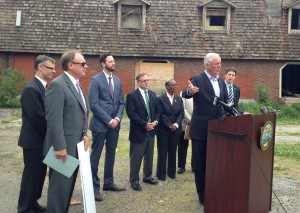Study: Blight proves an adaptive foe
Stamford-based Keep America Beautiful, a national nonprofit that envisions a country of clean, green and beautiful communities, recently released a study titled “Charting the Multiple Meanings of Blight: A National Literature Review on Addressing the Community Impacts of Blighted Properties.” Its overarching theme is that actions bring results and inaction courts blight in manifestations from litter-strewn lots to abandoned factories to rural ditches that serve as pop-up dumps.
The report provides “a snapshot” of how researchers, experts and practitioners describe and understand the conditions that create blight and the policy responses that communities, including Norwalk, are taking to fight it.
Cecile Carson, senior director of Keep America Beautiful, said, “We often refer to the ”˜Charting the Multiple Meanings of Blight”™ study as ”˜The Cost of Doing Nothing Study.”™ We want to be able to tell our government officials, businesses and partners about the costs associated with not cleaning up the dump in the vacant lot down the street, not planting the community garden and not providing a safe place for our children to play.

- Bridgeport Mayor Bill Finch and redevelopment officials in front of a blighted Bridgeport property, the former AGI Rubber Co. building. Photo by Danielle Brody
“What is the trade-off?” she asked. “What is it costing our community in lost business investment, public health, tourism? By collecting research on blight and the meaning of blight, we will be able to better explain our role as the affiliate and how the actions we take make a difference.”
The national report factored more than 300 academic articles and special policy and practitioner reports devoted to blight. It was prepared by the Vacant Property Research Network at Virginia Tech in collaboration with Econsult Solutions Inc., a Philadelphia-based consulting firm.
The study found the term “blight” is most often thought of as an urban problem, but it is universal. In rural areas illegal dumping causes blight and abandoned buildings cause blight in urban, suburban and rural communities irrespective of surrounding populations.
Norwalk resident Jim DelGreco works for Global Employment Solutions, a staffing company based in New York City. He heads Norwalk”™s Golden Hill Neighborhood Association and is co-chairman of the Keep Norwalk Beautiful affiliate of Keep America Beautiful. “I”™m really excited they”™re talking up the issue of blight,” he said. “The word has all sorts of connotations, many of them negative.
“Blight has been on our radar screen for years,” he said. “I did research on the Fairfield area towns and found that Stamford had the best program, though all are of benefit.
“For years, we pushed for passage of a blight ordinance,” he said. “We got resistance including excuses like ”˜violating property rights,”™ ”˜we have enough laws on the books to deal with these issues”™ and ”˜individuals will take out vendettas on others.”™ Two years ago the Ordinance Committee of Norwalk”™s Common Council held meetings on blight and eventually passed a blight ordinance thanks in large part to (Norwalk insurance businessman) Mike Geake. William Ireland, Norwalk”™s chief building official, was tasked with enforcing the new law.”
DelGreco said that since the ordinance”™s passage, more than 80 buildings have been cited for blight noncompliance. “This shows that blight is a very real issue for Norwalk,” he said.
Calling the Norwalk effort “grassroots,” DelGreco said, “It is attacking one neighborhood, one property, one open space, one graffitied wall, picking up one piece of litter at a time. The longer you leave a blighted property to deteriorate the worse the neighborhood becomes because people react to deteriorating conditions by letting their property go. The reverse is true. When I maintain my property, my neighbor takes care to do the same.”
Jennifer Jehn, president and CEO of Keep America Beautiful, said, “This research will contribute significantly to the understanding of blight, a critical environmental, economic and social issue Keep America Beautiful and our affiliates are strongly positioned to help address in urban, suburban and rural communities nationwide.
“The report will have an even broader impact because it will help us shape the development of measurement tools that will let us better assess and then prepare strategies to combat blight in all its forms at the community level,” she said.
Keep America Beautiful prefaced the study by saying, “While considerable research has examined the history of blight in the U.S., its role in national policy and the experience of communities living in blighted neighborhoods, little research has systematically examined the multiple meanings of blight across contexts. This project reviews and synthesizes knowledge about blight, broadly conceived, and draws together academic literature and practitioner reports to systematically assess the nature of blight, the effects of blight, the factors that have shaped its development and how understandings of blight have changed over time.”
Keep America Beautiful and its network of community-based affiliates plan to build on the report to develop a blight cost calculator for community groups and local governments.
The executive summary and full report is available on the Keep America Beautiful website.